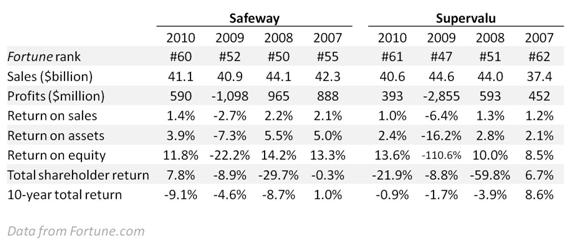Which Strategy is Right for My Company? Part 3- Speaking the Same Language
Previously, in “What They Want,” we explored how your competitors’ and colleagues’ perspectives on success can affect your market and your company.
Here we’ll see how people use the same words in the same way and mean different things, and how that can affect your decision-making about strategy.
How much of a good thing
At the start of this series we saw a financial scorecard for the Safeway and Supervalu supermarket chains. It looked exactly like this:
Of course we care about things other than financial metrics: corporate responsibility, customer satisfaction, employee satisfaction, and much more. But for now, let’s stick with that scorecard.
Here’s the challenge for you: decide which of the companies is doing better.
That’s a rhetorical question, and the same one I asked earlier in this series. I’m asking it again to make a different point. Even though those metrics use different scales, even though there is no indisputable, objective way to say that return on equity is more or less important than 10-year total return, we clever humans still answer the which-is-better question.
We answer the question by making tradeoffs. We decide, often unconsciously, how much of this good thing would it take for us to sacrifice how much of that good thing.
Tradeoffs
Imagine that you’ve decided Safeway is doing better. You encounter another reader at a pleasant bar, and you discover that the other reader rates Supervalu higher. You debate, most amiably. Not unlike debates about baseball players, cool cars, and tastes great / less filling. Not unlike debates about which direction to take your company.
Look again at Safeway and Supervalu. There is no dispute about the numbers themselves. The only way you can reach different conclusions while using the same numbers is by making different tradeoffs.
If you and the other reader at the bar don’t discuss how you make tradeoffs, the most you can do is reach a compromise. If you want to reach consensus about which company is performing better, you must first agree how to make tradeoffs.
If you make tradeoffs differently, you are, in effect, speaking (or calculating) different languages. You would be mentally calculating an overall-goodness score for Safeway using your set of tradeoff rules for the metrics; the other reader at the bar would use a different set of tradeoff rules. Same data, different language, different answers.
Case example
I worked with the executive team of a company that kept arguing, arguing, arguing about what strategic direction they ought to go. It occurred to me that they were really arguing about how to make tradeoffs, not about the merits of the options they faced.
So, using an approach I mentioned in part one, I turned a market-research technique inward on the team instead of outward on the market. It let me privately and confidentially gauge how each executive made tradeoffs among four measures of success.
The results were fascinating. Of course everyone liked all four of the metrics, just as you presumably like all of the financial metrics in the supermarket example. But, in one especially stark instance, one person put a 2% “weight” on employee satisfaction (one of the metrics), and another person put a 70% weight on the same metric! The first person would trade away some employee satisfaction in return for a small gain in another metric, whereas the second person would demand massive compensation for the same sacrifice. Both of them honestly and sincerely valued employee satisfaction, yet their different tradeoffs amounted to them speaking different languages, languages the other couldn’t understand, about which strategy was best.
The president of the company stood up and announced that they weren’t leaving the room until they came up with a shared definition of success. They debated how to make tradeoffs, and in a few hours they had a prioritized list of what they valued. They published that list throughout the company so that everyone would be on the same page (literally).
View Part 1 of the Series – What You Want
View Part 2 of the Series – What They Want
Coming up next
So far we’ve discussed your objective; your definition of success, and how it affects you, your company, and your competitors. Success is where you want to go. In the next installment we’ll start talking about routes to get there.
___________________________
About the author
Mark Chussil is Founder and CEO of Advanced Competitive Strategies, Inc. and a 35-year veteran in competitive strategy. He has designed strategy simulators and conducted business war games for dozens of companies, in many industries, around the world, helping them make or save billions of dollars.
A highly rated and entertaining speaker, Mark speaks about strategic thinking at conferences and in corporate workshops. He has written three books, chapters for five others, and numerous articles, and he has been quoted in Fast Company, Harvard Management Update, The Wall Street Journal, and other publications.
Mark is also a Founder of Benefitics, LLC (which quantifies Social ROI for non-profit organizations) and a Founder of Crisis Simulations International, LLC. He earned his B.A. at Yale and his M.B.A. at Harvard.
Category : Business Growth & Strategy


